The Air Force has begun shedding its traditional fighter- and bomber-centric culture, deliberately shifting strongly toward what its leaders call a “balanced approach” to airpower. In so doing, USAF has begun to broadly raise the profile of other, less well-known capabilities in the USAF arsenal.
Cast for much higher profile roles are functions such as worldwide situational awareness and cyber operations. At the same time, the service seeks renewed competence in areas of strategic nuclear deterrence and irregular warfare.
There will also be a steady migration of missions away from aircraft flown by onboard humans to those piloted remotely.
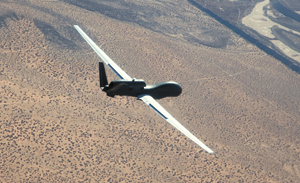 |
A Global Hawk Block 30 en route to Edwards AFB, Calif. |
While this shift is under way, the Air Force will be challenged as never before, often by enemies who employ hard-to-defeat asymmetric means. Adversaries are either developing or can simply buy or steal world-class technology to compete with USAF. The service must somehow maintain its technological superiority despite what are expected to be flat defense budgets for the foreseeable future. It will also have to rebuild an atrophied and dysfunctional acquisition system.
Such was the self-portrait drawn by top USAF leaders at the Air Force Association’s annual Air & Space Conference, conducted just outside Washington, D.C., in mid-September. It was a picture affirmed by Pentagon officials, too.
Secretary of Defense Robert M. Gates, in his keynote address, praised the Air Force for skillful conduct of the wars in Iraq and Afghanistan, as well as in numerous combat and humanitarian operations nonstop over the last 18 years.
The service has been “usually unheralded and unrecognized” for what it has “experienced, endured, and accomplished in recent times,” fighting “protracted air campaigns that have accelerated the wear and tear on the service’s people and aging inventory,” he said.
He detailed the key roles the Air Force is playing in the war, with precision attack, airlift, cyber defense, special operations, communications, and intelligence-surveillance-reconnaissance. The service’s contribution is indispensable, Gates said, asserting that “there can be no national security” without the Air Force.
The recognition by the defense chief was welcomed by attendees, who had seen many of the service’s key programs terminated, reduced, or deferred by Gates in the 15 months since he took the resignations of the previous USAF Secretary and Chief of Staff, Michael W. Wynne and Gen. T. Michael Moseley.
At that time, Gates said the Air Force needed fresh leadership after missteps in the handling of nuclear weapons, what he perceived as Air Force obstinacy in adopting unmanned aerial vehicles, and in its insistence on planning for “unlikely” future wars instead of focusing on the current, irregular fight.
Under new management, Gates asserted, the Air Force has moved decisively to reinvigorate its nuclear enterprise and has gotten the message on UAVs, having “increased the number of Predator and Reaper combat air patrols in theater by more than half from last year.” He said the number of CAPs will grow to 50 by the end of 2010.
 |
F-35 #AA-1 on the first test flight by a military pilot, USAF Lt. Col. James Kromberg. |
Now, though, Gates said the Air Force must go further.
“In this dangerous new century, our country faces a fiendish and complex array of threats, and our military confronts a bewildering array of tasks.” To overcome the challenges, he said, the members of the defense establishment must be willing to “stretch their comfort zones and rethink long-standing assumptions” about how the US military should be structured and equipped.
An Inflection Point in History
The Air Force should emulate its own founding father, Billy Mitchell, Gates asserted, saying Mitchell had the “vision and insight to see that the world and technology had changed” and then “pressed ahead in the face of fierce institutional resistance” to bring his vision to reality.
Secretary of the Air Force Michael B. Donley, in his address, said the Air Force has reached nothing less than “another inflection point in its history, where changes in the strategic environment, new technologies, and changes in resources together combine to reshape our capabilities and to set us in new directions.”
He contrasted what in 2000 was forecast to be USAF’s force structure in 2020 with the one now actually taking shape for that year. The actual force will have far fewer fighters and bombers, fewer people, and fewer satellites than envisioned nine years ago. However, it will have a much more robust capability in special operations and a reinvigorated nuclear enterprise, and instead of the forecasted 80 UAVs, “today’s glide path takes us to over 380, with the strategic and cultural implications vastly greater than those numbers alone would indicate.”
There’s been a “consistent shift away from investment in just the combat forces and toward the joint force enablers” in ISR and exploitation of collected information, tanker support, airlift, and cyber operations, Donley observed.
“It’s clear that we are not building the Air Force we thought we would build back in 2000,” he acknowledged.
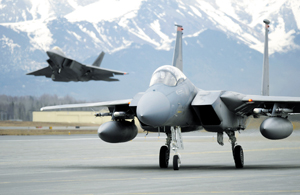 |
An F-15 from Kadena AB, Japan, taxis as an F-22 from Elmendorf AFB, Alaska, takes off. Both took part in training during the exercise Northern Edge in Alaska. |
The new force, though, will have “more strategic balance,” Donley said, to address increasingly complex threats likely to combine both unsophisticated methods and high-tech capabilities at once.
These threats “should not be classified as regular or irregular, high end or low end,” Donley said, and the Air Force will have to possess “a portfolio of military capabilities with maximum versatility.”
At the fulcrum of the new balanced Air Force will be ISR, which he called “the linchpin of today’s fight.” Through more robust ISR and “rapid and seamless … analysis,” there will be better decision-making and better application of USAF’s limited assets to achieve the maximum effect.
Gates, in his address, denied that his April budget decisions—to terminate production of the F-22 fighter, defer a program to build a new bomber, and cancel a foundational satellite program—were intended “to reorganize and rearm the entire US military to hunt insurgents, and do nation building, or to fight wars just like Iraq and Afghanistan.” While the Air Force is putting significant monies toward irregular warfare, he said, it is a small amount compared with the service’s overall budget.
The IW area is “not exactly an existential threat to overall modernization accounts,” he observed. However, rushing new counterinsurgency tools into combat as quickly as possible is “the most important thing to do,” he insisted.
Donley also noted that some specialties—such as explosive ordnance disposal, aeromedical evacuation, security forces, engineering, and even contracting—have unexpectedly come to the fore in Iraq and Afghanistan, and “the broader lesson is that this full range of capabilities is necessary for the effectiveness of our nation’s joint expeditionary team.”
Gates noted that the Air Force is “currently training more pilots for unmanned systems than for fighters and bombers,” and is looking at “inexpensive, rugged” light strike and mobility aircraft suited to irregular warfare.
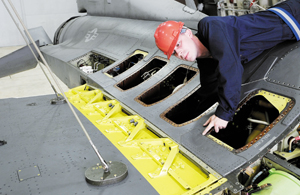 |
At Osan AB, South Korea, SrA. Malcolm Asher loosens a wing bolt on an F-16. The wing is being replaced due to corrosion and cracks found during routine inspection. |
Command of the Skies
He recognized that the shifts required of the Air Force are profound and demand a change in culture. The evolution is doubtlessly making former Chief of Staff and airpower legend Gen. Curtis E. LeMay “spin in his grave,” Gates gibed.
Manned combat aircraft remain the most powerful element of the Air Force, though, and it would be “unwise to assume that conflicts of the future will be like those of today or the past,” Gates said. He promised not to replay the “folly” of the Maginot Line by assuming that the air dominance the US enjoys today will persist unchallenged.
“It would be irresponsible to assume that a future adversary—given enough time, money, and technological acumen—will not one day be able to directly threaten US command of the skies,” Gates acknowledged.
He pledged to support the F-35 program, which, at $300 billion for the Air Force, Navy, and Marine Corps, represents “a truly massive investment in the future of US airpower.” He said the program will be carefully managed and any problems “aggressively confronted” to make sure the F-35 program succeeds. He also said the F-22, although curtailed at 186 aircraft, will be receiving $6.5 billion worth of upgrades “over the next few years … to be fully mission capable.”
Donley said that the financial straits of the Air Force mean “it will be increasingly difficult to justify modifications to older aircraft that will not be part of our long-term future capability, especially when those programs experience significant cost growth and constrain our ability to field the next generation of systems.”
Gen. Norton A. Schwartz, Chief of Staff, told reporters that Donley was referring to programs such as the C-130 Avionics Modernization Program, now a candidate for termination due to budget and schedule slips. Schwartz said that legacy fighters that the Air Force decides to retain will be given infrared search-and-track systems, active electronically scanned array radars, new data links, and other improvements.
“There is a conscious intent to make sure that those legacy birds that we’re going to keep are, in fact, very good platforms,” Schwartz asserted.
Regarding the C-130, it’s an issue of affordability, he said.
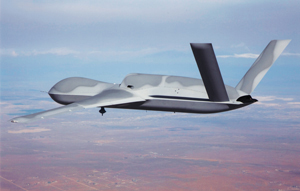 |
An Avenger UAV (owned by General Atomics) on a test flight over the Mojave Desert in April. USAF is now training more pilots for UAVs than for fighters and bombers. (General Atomics Aeronautical Systems photo) |
“If there were more money, we probably would not choose” to cancel the AMP, he said, but “what we will do is install the essential … things that will make the airplane compatible with the airspace, … and that doesn’t necessarily require a completely integrated glass cockpit.”
All speakers agreed that the Air Force’s No. 1 acquisition priority is to get a new tanker program moving again—and delivering aircraft as soon as possible.
Gates offered an olive branch, announcing his restoration to the Air Force of the authority to run the tanker recompetition and choose the winner. He had taken that authority away after a number of contractor protests were upheld, landing the project in political gridlock. Gates terminated the program last year, preferring to start over rather than try to salvage a hobbled acquisition.
Schwartz noted that efforts to reinvigorate the Air Force’s nuclear enterprise have been a major undertaking in the last year. He pointed to the creation of Global Strike Command, the reinstitution of regular readiness inspections, and increased funding for testing and safety support functions as major milestones in restoring “credibility” in the nuclear mission.
“We invested $4.4 billion in areas that, frankly, had been neglected,” Schwartz said in his address. However, “Secretary Donley and I will not take the counsel of those who say … the job is complete. Our commitment is to follow through.”
Schwartz said, “It took years of atrophy to set in, and we cannot afford to stand pat on the gains of the last year by being complacent now.”
The Air Force can “take pride,” Schwartz said, in the fact that it has “strengthened the trust” of the Office of the Secretary of Defense, in USAF, “not only as stalwarts of the nation’s nuclear arsenal but as a fundamental provider of essential combat capabilities.” Bonds with the other services have also been “reinforced,” he said.
Over the past year, “we were asked to put out some wildfires,” he noted, and now that many of the crises of last year have been addressed, if not fully resolved, “we must raise our sights to focus on the longer-term vision.”
Schwartz said he has chartered USAF’s chief scientist, Werner J. A. Dahm, to “identify the most promising technologies our Air Force can adopt, to give us the flexibility to respond to the changes in all aspects of warfare—irregular, conventional, and nuclear.”
A new “long-range strike and reconnaissance capability” will figure prominently in the Air Force’s revamped force structure, Schwartz said. It’s an essential system because the Air Force must preserve its ability to penetrate “contested airspace, so that we may range and credibly engage any target in the world.”
Gates said he is committed to a new bomber-like system, but said the Air Force must come up with a way to acquire one that is not so expensive that it can’t be built in operationally useful quantities.
“What we must not do is repeat what happened with our last manned bomber,” Gates said, noting that the B-2 wound up costing $2 billion apiece when production was slashed and the cost of development and production facilities was added in.
 |
Air Force Chief of Staff Gen. Norton Schwartz delivers his keynote address to attendees at AFA’s Air & Space Conference and Technology Exposition. |
Something We All Worry About
“It makes little sense to pursue a future bomber, a prospective B-3, if you will,” if production will be so small that losing just one in an accident or combat “results in a loss of a significant portion of the fleet, a disaster akin to the sinking of a capital ship.”
Whether the new system is manned or unmanned “or some combination of the two,” Gates said the next bomber “should be one that can realistically be produced and deployed in the numbers originally envisioned.” It is key, he said, that “schedules are met, costs are controlled, and requirements brought into line with reality.”
Speaking with reporters after his speech, Donley said “we will have dollars in the 2011 budget for long-range strike,” but the funds would likely be for research and development.
“The question is, how fast after 2011 or 2012 such a program develops, and those are still issues to be resolved,” Donley reported.
Asked by reporters how the industrial base will be able to remain intact until the next combat aircraft program commences—potentially a hiatus of half a decade—Schwartz said that “it’s a real issue” and “something that we all worry about.”
“We endorse selectively maintaining industrial capability that would permit a surge or a more rapid ramp-up of a program, should the need surface,” he said. However, “it would have to be well-justified, because, again, each dollar that we use to maintain the industrial base, as strategically valid as that may be, means a dollar less for something else.” Schwartz noted that USAF submitted $140 million in its unfunded priorities list for Congress (programs desired but not budgeted) “to maintain certain technology threads that would be useful for any long-range strike platform, … radars, apertures, data links, things of that nature.” However, “whether we can sustain large design teams without work is another matter entirely. That’s a challenging question … that goes well beyond the Air Force.”
Donley said that the reshaping of the service has required “very difficult and sometimes painful … trades,” but that the Pentagon leadership believes it is striking the right balance between capabilities to get maximum effect from the available dollars.
“We’re not in a situation where we can adapt the changing requirements by adding people and money,” Donley warned. “We are almost assured of little- to no-growth defense budgets in the coming years.”
This will also require a change in “our perception of risks,” he added. “We may accept short-term risk for a longer-term gain.” The F-22, for example, was a case where he and Schwartz felt the benefit of buying more aircraft was outweighed by other, more pressing needs. The early retirement of more than three wings’ worth of older fighters, he added, will free up “over $3.5 billion … to modernize Air Force fighters and bombers that will be with us for the long term,” while the 4,000 personnel slots saved will be shifted to “exploit and disseminate intelligence … and to provide added manning for nuclear deterrence operations.”
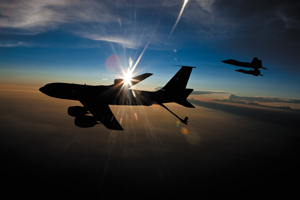 |
Two F-22 Raptors maneuver into position behind a KC-135 Stratotanker before refueling during a mission over Florida. |
Resetting the Air Force
Donley admitted, “Certainly there are risks in these decisions.” However, he said that while no American service member has been attacked by an aircraft in more than 55 years—“and certainly we intend to keep it that way”—the last time a service member came under cyber attack “was at the beginning of this sentence.” The Air Force, Donley said, must “reset.”
“The strategic environment, new technologies, and a full cycle of resource changes—first up, then down, then flat—have brought us to a different place, and they compel us in new directions.” The Air Force, he urged, “must be bold and embrace change. … We have been challenged many times in our history, and this is yet another test.”
Gates forecast that USAF will be “tested even more … in the coming months,” because the war in Afghanistan is entering “a decisive phase,” and airpower will be of paramount importance in conducting it.
“In a landlocked nation with mountainous terrain and few usable roads, we and our allies are far more dependent on airpower to protect troops and move supplies,” he said.
Moreover, without the constant flow of air-delivered support in the form of intelligence, surveillance, and reconnaissance, logistics, and on-call precision strikes, “the entire US war effort would simply grind to a halt,” Gates admitted.
| Nuclear Forces: Lots of Progress, But a Long Way To Go
By Michael C. Sirak In the view of senior USAF leaders, the Air Force during the past year has made significant progress toward bolstering oversight of ICBM and nuclear-capable bomber forces and laying the foundation for sustained excellence in the execution of its nuclear-related responsibilities. This view was offered on more than one occasion at AFA’s Air & Space Conference held Sept. 14-16 on the outskirts of Washington, D.C. “Credible deterrence is what this is all about,” said Maj. Gen. C. Donald Alston, assistant chief of staff for strategic deterrence and nuclear integration. The wide-ranging initiatives put in effect across the nuclear enterprise are “pressing the fight on all fronts” to ensure that the processes and organizations are in place “to provide credible deterrence every day,” said Alston. He added, “We have fantastic focus and extraordinarily, exquisitely committed young men and women who are making this job work every day.” Despite the progress, the work to reinvigorate the nuclear enterprise is nowhere near complete. While the “large muscle movements” have already occurred, such as activating Air Force Global Strike Command, standing up the Air Staff office for nuclear matters, consolidating nuclear sustainment functions, and creating a fourth operational B-52H bomber squadron, cementing these changes and building up a deep cadre of airmen with nuclear expertise will take years, the service leaders said. There is no time for letting up. “We have to continue to be vigilant and focus to ensure that we produce the level of precision and reliability that’s demanded of us,” said Air Force Chief of Staff Gen. Norton A. Schwartz. Schwartz continued, “Our commitment is to follow through, and that commitment should not be underestimated.” Consistent with that, one of the Air Force’s top priorities remains reinvigorating its nuclear enterprise. Global Strike Command, activated on Aug. 7 at Barksdale AFB, La., now provides the Air Force with a single command to manage the service’s Minuteman III ICBMs and its nuclear-capable B-2A and B-52H bombers. It will be a voice of advocacy for these weapons systems and the airmen who operate them, maintain them, and protect them. “As important as other defense priorities may be, … there is none more important than our special responsibility for nuclear weapons,” said Lt. Gen. Frank G. Klotz, commander of the new major command. “This awesome capability,” he said, “demands our constant and undivided attention. This was true in the past, it’s true now, and it will be true into the future, regardless of the size or composition of our nuclear deterrents and global strike forces.” The new command is building toward the goal of full operational capability by the summer of 2010, with about 900 headquarters personnel and nearly 23,000 personnel overall. Responsibility for the ICBM mission is expected to come under Global Strike Command’s authority on Dec. 1 from Air Force Space Command when 20th Air Force, which oversees the nation’s 450 Minuteman IIIs, transfers over to it. Eighth Air Force, with its 20 B-2s and 76 B-52s, will make a similar move to Global Strike Command from Air Combat Command on Feb. 1, 2010. One issue of concern expressed by these leaders is the advanced age of equipment in the nuclear enterprise. This includes not just the bombers and ICBM systems themselves, but also the missile warheads and nuclear gravity bombs, as well as the vital test and support equipment and the helicopters that secure the nation’s ICBM fields. Klotz said, for example, that the Air Force has “underinvested” in the test and support equipment over the years, meaning this equipment is today “tired, worn out, dare I say, antique.” Maj. Gen. Roger W. Burg, commander of 20th Air Force, said the Air Force has already pumped about $6.2 billion to extend the life of the 1970s-era Minuteman III out to circa 2020 through modernization of components such as the missile’s guidance set and solid-propellant rocket motors. It has also spent about $1.4 billion to modernize security systems for these ICBMs, he said. But subsequent to the start of this modernization, Congress has directed the Air Force to maintain the missiles out to 2030. “If you ask me [what is] my confidence in that fleet responding to 2020, I’d have one set of confidence factors,” explained Gen. Donald J. Hoffman, commander of Air Force Materiel Command. He continued, “But we’ve now been given the task of looking to make it stretch out to 2030. My confidence in that is considerably less.” Alston said the Air Force is assembling a master document that will capture all of the sustainment and modernization plans across all of the service’s nuclear capabilities. Its purpose is to provide greater transparency for the leadership that nuclear requirements are being properly addressed. Already, for the first time in about a decade and a half, the Air Force has published an ICBM systems roadmap to plot the path for sustaining the Minuteman IIIs, said Brig. Gen. Everett H. Thomas, commander of the Air Force Nuclear Weapons Center. His organization has also made great strides in returning thousands of nuclear-weapons-related material assets in the military supply chain to Air Force control. Another challenge facing the nuclear enterprise is its human capital of airmen for the mission. “We need to make sure that we’re developing them, incentivizing them to stay in the nuclear business, and being able to identify and retain them within the nuclear enterprise,” said Klotz. Alston said the Air Force has modified training and re-baselined its professional military education for the different ranks to expose “all airmen to the responsibility that the Air Force has to secure the strategic commons.” These changes will “more efficiently and more effectively produce that capability,” he said. “It’s going to take years to develop that bench strength and that depth that we need,” he added. |
| The Good, the Bad, and the Ugly
Speaking to attendees about the threats facing the Air Force in the 21st century, Lt. Gen. David A. Deptula, deputy chief of staff for intelligence-surveillance-reconnaissance, said USAF has enjoyed great success in the past because “we anticipated change and adapted air, space, and cyber capabilities to meet the threat.” However, the threat has changed radically, becoming more sophisticated, more powerful, and more dangerous. The Air Force “cannot afford” to let its guard down, he said. Deptula noted that, in nearly all of the last 18 years of constant combat, the Air Force has enjoyed a “permissive environment,” one largely without an air-to-air or surface-to-air threat, so that USAF can fly where and when it wishes. However, potential adversaries are “learning from our successes. They’ve been very good students” and hope to deny USAF “in the future the advantages we’ve worked so hard to attain.” “We have enjoyed an unprecedented freedom to operate in air, space, and cyberspace. Threats are now emerging that will limit that freedom in every domain and in every phase of operation and execution.” The approach of emerging or re-emerging powers to thwart USAF technology “is to steal it, copy it, study it, emulate it,” Deptula said. He explained that top-flight digital technology has migrated to other countries because “dual-use technology” that can improve weapons as well as consumer goods is hard to restrict. Counterfeit computer components built into US systems are sometimes found to have “backdoors,” so that the producing country can gain access to US secrets over the Internet “without leaving the safety of their own intelligence facilities.” Further, Deptula said that digital technology is making it easier for adversaries to network their defenses, and tougher to cripple enemy defenses by striking a particular node. “What one sees, they all see,” he said. Damaging part of a network may not bring it down. The emergence of cyber warfare “and a glut of modern military hardware for sale has led to a new breed of well-equipped adversaries,” Deptula asserted. “Double-digit” surface-to-air missiles are expected to soon reach ranges of more than 800 miles. That and new aircraft with capabilities approaching those of the F-22, but in “F-35-like quantities,” are pushing the Air Force farther away from aim points that it can reach without being detected or targeted. Those new fighters, being developed in China and Russia, will also likely be exported at prices that will “undercut” the F-35, which is the intended US export fighter for the next 30 years. Deptula added that “we may be facing a fighter threat capability in quantities that we’ve never experienced before,” in both quantity and quality. “One thing is certain,” Deptula asserted. “We can’t go back. The future threat environment will not be like that which we’ve seen in the past.” |